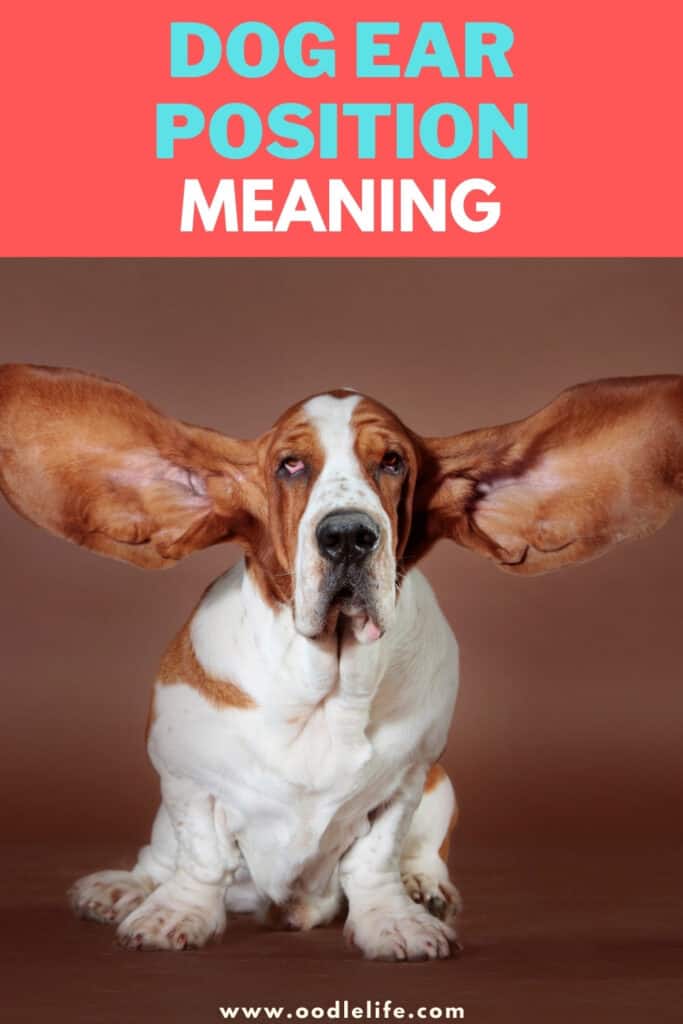Dog Ear Position Meaning (Dog Ear Positions Chart) + Photos
As much as we love our four-legged family members, communication will always be a difficult task. It still feels like a miracle when a dog finally understands the meaning of “sit” or “stay.” It can feel like you’re bonding with your canine companion, even in a limited way.
But, we can mistakenly assume that they understand more than just those few keywords.

I find myself having whole conversations with my dogs, though one-sided. But did you know there are ways that we can start to learn the universal language of pups a little better too?
While we communicate with our words, dogs express themselves through meaningful movements and gestures. This body language puts everything to use, from the tail to the ears.
By learning what your dog is expressing through his ears, you can begin to understand him even better to find out what he likes and dislikes the most.
Understanding the dog ear positions chart can also help to protect you in case you ever encounter an unfamiliar dog that may exhibit threatening messages with his ears.
Find out below what your dog is trying to tell you. Even when pups are silent, the ears may speak volumes!
The Body Language of Canines
When you want to read the body language of your pet, the most common expressions come from a dog’s posture, facial movements, and tail movements.
To properly decipher the meaning of a dog’s ears, you must interpret the ear position in context with every other signal. For example, a wagging tail does not always indicate a playful dog, especially if he is showing other signs of aggression or assertiveness like raised hair, bared teeth, or pointed ears.
However, not all dogs’ ears hold the same shape. Because of the way different breeds are built, not every dog will be able to exhibit the full range of positions.
But don’t worry–your floppy-eared friend can still communicate these emotions to you if you pay attention. By examining movements at the base of the ear, you can discern what movements your dog is instinctively making.
With these factors in mind, you can learn all about what a dog’s ears can indicate. While these signals don’t guarantee any specific actions or intentions, they can certainly suggest a dog’s general mood or emotional state.

What are the Common Meanings?
As you can see on the dog ear positions chart, there are four main categories for a dog’s ears. These include relaxed, flat, perked, or pointed. A dog in different situations will likely utilize these positions to express their state of mind to other dogs or threatening figures.
Since a dog’s ears are readily seen by others, changing its position is a quick way to demonstrate a state of submission, aggression, or calm. Additionally, the direction a dog’s ears are facing can reveal what they are interested in at that moment since they will point towards the sound they want to identify.
Perked/Attentive
A key feature of perked ears is the increased muscle tension in a dog’s face and body. You will notice that a dog perks his ears in response to interesting noises that he wants to investigate.
Whether your dog is standing still in a crowded park or is waiting for the magic word to earn a treat at home, he might perk his ears to communicate that he is alert and ready for action.
Since ears serve a critical function for dogs, they often move their ears into positions that aid their senses best without the intention to communicate to others. In other words, your dog might have his ears perked simply to hear better.
Regardless of the intention of your furry friend, you can notice when his ears are tensed, angled forward, or raised to know that he is listening out for sounds that interest him.
While perked ears are not a concerning signal in isolation, it is helpful for a dog’s human to notice when they perk their ears. If listening for a noise that becomes threatening to a dog, their ears could move positions from perked to flattened or pointed, indicating a more threatening issue.

Flat
A dog that experiences fear or submission will often move their ears back and down. You will usually notice this behavior when their ears seem to become flatter and closer to the dog’s head.
Since dogs rely heavily on their sense of hearing to protect their safety, it may be surprising when you see a dog purposefully flattening his ears to limit his hearing. One of the primary functions of this behavior is to communicate fear or submission.
By inhibiting his critical sense of hearing, a dog is suggesting to a human or another dog that he is at the mercy of others.
If you have ever seen a cowering dog on the street or met a rescue who has suffered abuse, you will likely see flattened ears in addition to other postures of submission or fear. However, you can’t always be certain that flattened ears mean that the dog will remain in this submissive state.
Other lighthearted examples of flattened ears occur among dogs also. This behavior occurs in dogs that are very comfortable with their owners. Since flat ears can also communicate submission or friendliness, your dog may approach you with his ears back to communicate politeness and respect.
Keep an eye out for situational factors and other body language signals to determine whether your dog is expressing submission due to a perceived threat or a feeling of safety.

Relaxed
Even when your dog is not deliberately moving his body or ears, he can still be communicating with you. Holding his ears in a relaxed position allows your pup to send a clear message to other dogs or people about his state of mind.
When your dog’s ears are relaxed, he expresses contentment and calmness. You will often see that other muscles of the face are relaxed and the body is totally at ease. This is a good sign! Your dog is saying that there are no worries on his mind and he feels safe with you.
Dogs in the Spitz family have naturally erect ears. Huskies, Corgis, Chihuahuas, and others also have pointed ears. So, you will see relaxed ears in a slightly angled direction resting on top of their heads.
Other breeds like the Beagle and Dachshund have folded ears. You will see the base of the ear in a neutral position while the outer ear hangs comfortably.
A dog with relaxed ears may be about to fall asleep or he may just be very confident in his surroundings. When you find that your dog relaxes his ears, you can celebrate that he is a happy pup!

Pointed/Aggressive
A dog with pointed ears may be indicating to humans or other dogs that he is alert and ready to defend himself if necessary.
On the dog ear positions chart, this posture is a combination of the perked and flattened positions. Pointed ears can most readily communicate aggression or tension in a dog’s disposition. This is because a dog who senses danger will tense his ears towards the threat while also lowering the tips to communicate defensiveness.
If you have seen a dog exhibit this behavior, you likely knew immediately that they wanted some space from you. Not every instance of pointed ears will lead to an aggressive dog, but most aggressive dogs will hold their ears in this position.
Since pointed ears can be a combination of both alertness and fear, humans must analyze the situation to determine why a dog is feeling threatened. A dog may be intimidated by a threatening dog or human, territorial over a favorite toy, or suspicious of a threatening sound to hold their ears this way.
Since there will likely be other bodily signals of an aggressive, you can assess the whole situation to determine what your dog needs. If he is barking and lunging or leaning forwards with pointed ears, he may be more likely to initiate contact. If your dog has a tucked tail and makes whimpering sounds, he could be more fearful than aggressive.

Dog Ear Positions Chart
| Position | Emotion |
| Relaxed | Neutral, Calm |
| Flattened | Fearful, Anxious, Defensive |
| Perked (Tensed, Forward) | Curious, Attentive, Confused |
| Pointed (Tensed, Flattened) | Alert, Aggressive, Fearful, Defensive |
Conclusion
Your dog’s ears are great for both listening and communicating. With key emotions and behaviors being consistent across all breeds, you can have a better understanding of what your dog may want or need in any given situation.
The primary ear positions range from fearful to neutral to aggressive. Just as emotions exist on a spectrum, your dog’s ears do too. When interpreted in context with any other body language, this can offer reassuring insight into how your dog may behave.